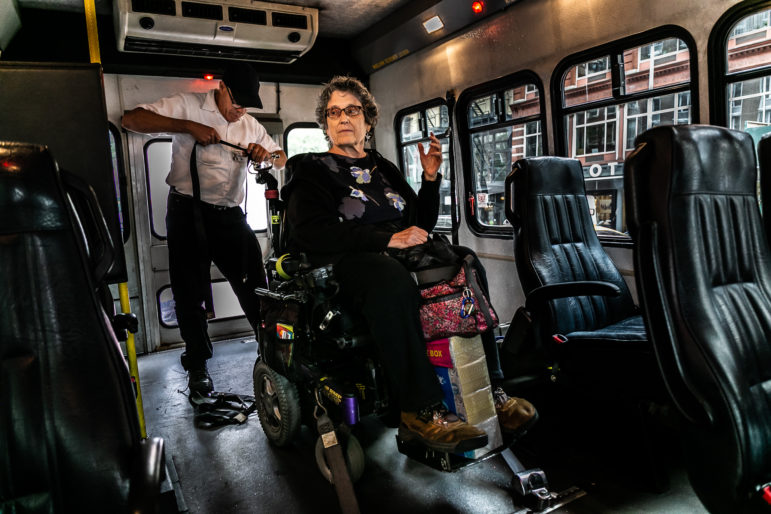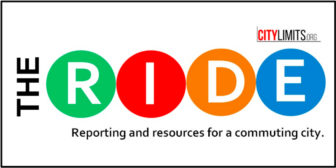
Adi Talwar / City Limits
Jean Ryan, a member of the advocacy group Disabled in Action, waits for her wheelchair to be harnessed in an Access-A-Ride van.
The MTA is expected to vote later this week on a plan to raise fares for transit riders, and one of the proposals on the table would increase the base fare to $3 per ride—a hike that would disproportionately burden Access-a-Ride users, who are forced to pay cash for their trips, riders and advocates argued Tuesday.
The transportation authority has proposed two options for fare increases, which are slated to take effect in March. The first would retain the current $2.75 fare price, but eliminate the existing 5 percent bonus for purchases over $5.50. The second option would hike the base fare to $3, but offer a 10 percent bonus on any transaction over $6, according to the plans.
It’s the second proposal that’s drawn the ire of those who use Access-a-Ride (AAR), the MTA’s shared car service for New Yorkers with disabilities. AAR users cannot use MetroCards to pay for trips on the system, and instead are required to pay the exact fare in cash—meaning they won’t be eligible for the 10 percent bonus under the MTA’s second fare hike option. So while many subway and bus riders would be able to take advantage of the bonus, bringing their adjusted base fare down to $2.73 per ride, AAR patrons would be forced to pony up the full $3 each trip.
“All of those discounts that should be available to everybody are not available to people with disabilities who are AAR users,” said Ruth Lowenkron, director of disability justice at New York Lawyers for the Public Interest, one of several people who testified about the issue before MTA board members at their transit committee meeting Tuesday.
The current $2.75 fare paid by AAR users, another paratransit user testfied, is already higher than what most subway and bus riders who can purchase monthly or weekly MetroCards pay. Many who use AAR do so because they have fewer alternatives, as a majority of the city’s subway stations are still inaccessible.
“We already pay more,” the woman told MTA board members. “It’s a sad day when whether we can walk or not determines what the size of our fare is going to be.”
The fare hike would be especially egregious, another speaker said, since many AAR users complain the service itself remains cumbersome and inefficient: Riders must book their trips a day or two in advance and be outside to meet their drivers within five minutes of their scheduled pickup time, or the driver will leave. Since the service is shared, it can mean users are subjected to long, meandering rides—often to boroughs outside their destinations—to pick up and drop off other passengers.
“I can’t believe that there are proposals for a fare hike that would increase the cost of AAR trips by almost 10 percent, even though you know that most of the people that this would affect live on fixed incomes, and the service does not seem one percent better,” said Janice Bartley, a disability rights advocate.
Get the best of City Limits news in your inbox.
Select any of our free weekly newsletters and stay informed on the latest policy-focused, independent news.
The MTA says it’s working to improve accessibility on a number of fronts: New York City Transit President Andy Byford’s “Fast Forward” plan includes an initiative to install elevators at 50 additional subway stations in the next five years, and the agency hired its first accessibility adviser last year. It also rolled out a pilot program that allows about 1,200 AAR users to book their rides on demand through an app, a more flexible option than the current system.
But that e-hail program proved more popular, and expensive, than the MTA initially expected, and overall paratransit costs are increasing at a time when the agency is also grappling with declines in projected fare and dedicated tax revenue.
“Improving paratransit service is one of our top priorities, and popular new advancements like e-hail are contributing to steeply rising operating costs,” an MTA spokesman said in a statement. “An unchanged paratransit fare is one of the proposed options, the MTA Board will consider all public feedback before adopting any new fare structure, and as demonstrated in the past, the Board is not limited to the proposals already put forward.”
But advocates say the proposed $3 fare structure option is unfair not just to AAR users, but to low-income transit riders in general, many of whom aren’t always able to pay for more than a trip or two at a time and so can’t take advantage of the bonus, as those who can afford to pay more upfront can.
“A lot of people would be affected by an increase in the base fare, many of them people who really can’t even put together a handful of dollars for a couple of trips,” says Joseph Rappaport, executive director of Brooklyn Center for Independence of the Disabled. “It’s just wrong.”










One thought on “Proposed MTA Fare Hike Could Unfairly Impact Access-a-Ride Users, Advocates Say”
Pingback: Opposing The Un-Fare Hike on Access-A-Ride - New York Lawyers for the Public Interest